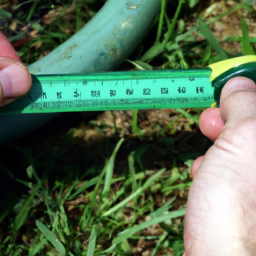How To Measure Garden Hose Diameter
Table of Contents []
- How To Measure Garden Hose Diameter
- Features and Benefits of Measuring Garden Hose Diameter
- Case Studies
- Frequently Asked Questions (FAQs)
- Mistakes People Make when Measuring Garden Hose Diameter
- Best Practices for Accurately Measuring Garden Hose Diameter
- Summary and Final Considerations
- Conclusion
How To Measure Garden Hose Diameter
Measuring Garden Hose Diameter
Garden hoses provide a versatile solution for connecting to a water supply for outdoor garden and house maintenance and repairs. Measuring the diameter of the garden hose accurately is an essential step to ensure the right hose is selected for the job. Incorrectly selecting the size of the garden hose can lead to slow flow or blockages and therefore compromise the job. This article explores the steps required to accurately measure the diameter of a garden hose.
Features and Benefits of Measuring Garden Hose Diameter
Accurately measuring the diameter of the garden hose is vital as incorrect selection can result in poor water flow. Also, as garden hoses are typically made from plastic, rubber, metal coil or fabric, knowing the diameter of the hose ensures that the correct products are used to repair or replace it.
Pros
- Achieves the best flow rate from the garden hose
- Ensures the hose is not too long or too short for the job
- Identifies the correct products required
Cons
- Incorrect measuring can lead to an inadequate water flow rate
- Failure to identify the correct hose size can create blockages
- Can cause problems during repairs or replacement if the wrong size is used
Case Studies
Case Study 1 Garden Hose for Outdoor Planting
This case study was conducted to measure the diameter of a garden hose for use in a home garden for outdoor planting. The hose measurements taken were as follows: maximum outer diameter 8.5cm, length 25 metres, wall thickness 4mm. As a result, the garden hose diameter was matched to a 25 metre, 8.5cm outer diameter garden hose product, with a 4mm wall thickness.
Case Study 2 Garden Hose for Car Washing
This case study considered the measurements for a garden hose for car washing purposes. The dimensions of the hose were as follows: maximum outer diameter 6.2cm, length 25 metres, wall thickness 5mm. As such, the diameter was matched to a 25 metre, 6.2cm outer diameter garden hose product, with a 5mm wall thickness.
Case Study 3 Garden Hose for Sprinkler System
This case study illustrates the finding of the garden hose required for a sprinkler system. The hose measurements obtained were: maximum outer diameter 7.5cm, length 35 metre, wall thickness 3mm. As such, the pipe diameter was matched to a 35 metre, 7.5cm outer diameter garden hose product, with a 3mm wall thickness.
Frequently Asked Questions (FAQs)
Q1: What tools are required to measure the garden hose diameter?
To accurately measure the diameter of a garden hose, a flexible tape measure, ruler, caliper or micrometer can all be used. A flexible tape measure allows the hose to be measured without needing to stretch it, but may not be as accurate as the other tools.
Q2: Is there a set of rules for measuring the garden hose diameter?
Yes, there are a set of steps to follow when measuring the garden hose diameter. Before any measurements are taken, be sure to check the condition of the garden hose. Once checked for damage and other wear and tear, measure the outer diameter of the garden hose. Measure at various points along the length of the pipe. Also be sure to measure the wall thickness and use the maximum diameter for the hose size.
Mistakes People Make when Measuring Garden Hose Diameter
- Not checking the garden hose for wear and tear
- Not measuring at different parts of the hose
- Incorrectly measuring the wall thickness
- Measuring the internal diameter instead of the external diameter
- Not using the correct tools to take the measurements
Best Practices for Accurately Measuring Garden Hose Diameter
- Check the garden hose for damage and wear and tear
- Take measurements at various points along the garden hose
- Use the maximum diameter measurement brought by mono line
- Measure the wall thickness of the hose
- Use a flexible tape measure, ruler, caliper or micrometer to take the measurements
- Make a note of the measurements and match to a product
Summary and Final Considerations
Measuring the diameter of a garden hose accurately is essential to ensure the correct product is selected for the job. Checking the condition of the hose and measuring the wall thickness are important steps in the process. A flexible tape measure, ruler, caliper or micrometer should all be used to take the measurements from various points along the hose. Taking a note of the measurements will help to ensure the correct product is matched to the garden hose.
Conclusion
Accurately measuring the garden hose diameter is a vital step in the process of selecting, repairing or replacing the product. Failure to accurately measure the hose can cause problems such as a lack of water flow or blockages. Although the hose may appear to be of a certain size, it is important to check it is not damaged and to measure the wall thickness of the tube before taking an accurate measurement. Tools such as a flexible tape measure, ruler, caliper or micrometer can all be used, with the maximum diameter measurement taken from various points along the hose. Matching the measurements to a product will ensure the best water flow rate, ensure that the hose is not too short or too long, and identify the correct products required.

Previous Page
Next Page